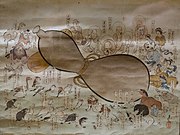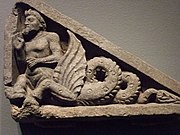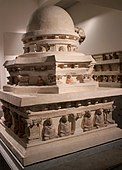Life of Buddha in art

Narrative images of episodes from the life of Gautama Buddha in art have been intermittently an important part of Buddhist art, often grouped into cycles, sometimes rather large ones. However, at many times and places, images of the Buddha in art have been very largely single devotional images without narrative content from his life on Earth.
The literary accounts of the life of
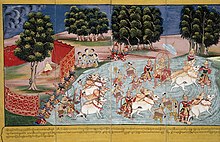

The 9th-century Borobudor reliefs illustrate the Lalitavistara Sūtra,[5] a Mahayana text, originally in Sanskrit, probably from the 3rd century. This only covers the life up to the Buddha's first Sermon. There is also a large body of Jataka tales, relating events from the many previous lives of Gautama Buddha, which were often subjects in Gandhara and early Indian art. By contrast, narrative scenes from the history of Buddhism after the Buddha's death are very few.[6]
In post-Gupta India a number of the most important scenes were grouped together; again stone reliefs on
The Historical Buddha

The "Historical Buddha" or
According to tradition, which is, as reflected in texts and art, effectively the only source for his biography,
He was married at 16, to the daughter of a Shakya noble. It was twelve years before a child was born, by which time Siddharta, then aged 29, had decided to renounce the life his father wanted for him, for that of a
He remained meditating at Bodh Gaya for six or seven weeks before leaving to spread the new teachings he had developed. His first sermon, known as the
The Buddha died in the company of some of his followers, according to tradition at the age of eighty. He was cremated, and his ashes and some of his possessions distributed to centres of his movement. The veneration of his relics, called cetiya, became important in Buddhism.[15]
The earliest biographical texts are all preserved only in manuscripts from much later, often with texts that have been translated into a non-Indian language, for example Chinese or Tibetan. Modern scholars believe that they probably contain later additions. They differ considerably in details, but generally are consistent with each other and with the earliest art regarding the main outlines of the life, which generally predates the textual versions that have survived. Even those believed to represent the earliest versions have many miraculous or legendary elements, which only increase in later versions.[16]
In the texts the life of the Buddha is followed with enormous interest by large numbers of gods and other figures, who sometimes come to earth to intervene or merely witness, as shown in depictions of the
Events shown in art: early life
Return to Earth

In Buddhism, the story of the Buddha's final incarnation begins before his conception or birth.[19] After great numbers of previous lives, the future Buddha, usually regarded as already a bodhisattva, was in the Tushita heaven when he decided to live a final life on Earth. After lengthy considerations,[20] he made his choice of a family to be born into. In some accounts, Maitreya was at this point named by the Buddha as the next buddha.[21] These scenes are often shown in art; at Borobudor there are 27 panels preceding Buddha's birth.[22]
Queen Maya's dream

Birth of the Buddha
The first of the Four and the Eight Great Events, and one of the most common scenes, although not appearing in the very early Indian stupas.
The Buddha was able to stand and take seven steps almost immediately,[28] a lotus flower springing up where each step went, and the baby standing on the final lotus may be shown, often in addition to him emerging from his mother's side. He raises his right hand towards heaven and declares "I alone am honoured in heaven and on earth. This triple world is full of sufferings; I will be the saviour from these sufferings".[29]
In East Asia this subject became popular by itself, the
-
Kushan dynasty, Gandhara. At right two female Nāgas stand ready for the bath.
-
Seven Steps, Kathmandu, Nepal
-
Buddha's first bath. Gandhara, 2nd century
Meeting with Asita
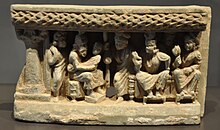
Soon after his birth, the king proposed following custom and visiting the city's temple to present the new-born to the gods. Siddharta, already able to speak, objected but in the end went. When the group arrived at the temple, the statues of the gods stepped down and prostrated themselves before Siddharta.[37] This episode is depicted at Borobudor.[38]
Childhood of Siddharta

Education

There are rare depictions of Siddharta astounding his teachers as a boy, or winning games or sporting contests with other boys by magical means. He received a princely education, and scenes of him learning martial arts, riding, archery and swimming may be found in extended cycles, as in two early Tibetan thankas.[39] Some Gandharan reliefs show him being driven to school in a small cart pulled by rams, perhaps reflecting local elite life; this detail is not in surviving early texts.[40]
In India, depictions reflect the emphasis in the texts on the high standards in physical princely skills expected by Siddharta's intended father-in-law.[41] An archery contest, naturally won by Siddharta, is sometimes depicted in Gandhara.[42] East Asian depictions place more emphasis on desk work, no doubt reflecting the local importance of passing the Imperial examinations of China, which began around the 6th century. In a 9th-century painted banner from the Mogao Caves, Siddharta actually appears to be taking such an examination.[43]
Meditation under the jambu tree
While still a boy,
Married life
Siddharta married Yaśodharā, when both were 16.[48] The wedding is sometimes shown in art,[49] as are contented scenes of the couple together.[50] After some twelve years they had a son, Rāhula, who was born the day that Siddharta left the palace for good. Siddharta's thoughts had increasingly turned to his spiritual life, especially after he saw the Four Sights (below). His father wished him to take the secular path, from the prophetic options offered before his birth, but a visit by a delegation of gods, urged him to pursue the life of dharma. This is sometimes shown in art, for example at Borobudor.[51]
The biographies record a moment when Siddharta was repulsed by the appearance of his female retinue, one or more of whom were sprawled on the floor asleep, concluding "It is true, I live amid a cemetery".[52] In Gandhara the scene (sometimes titled "Life in the Palace") is represented by Siddharta rising from a couch on which his wife lies, looking down at a female figure on the floor below.[53] At Borobudor there is a much larger group of figures sprawled on the floor, which immediately precedes the Great Departure scenes.[54]
The Four Sights

Living a life of luxury, Siddharta's parents took care to shield him from unpleasant aspects of the world,[55] but one day, riding through the countryside with his servant Channa, he saw the "four sights", firstly of a very old man, a very sick man, and a corpse. On a further trip he saw a mendicant monk or ascetic, whose tranquil bearing impressed him.[56] These turned his thoughts to a more spiritual life. They are not very often represented in Indian art, perhaps surprisingly,[57] but are covered at Borobudor in four panels,[58] and in more modern paintings.
Life after the palace
The Great Departure
The birth of his son, fulfilling his duty to provide an heir for the royal line, was apparently the trigger for Siddharta's abandonment of palace life to become an ascetic. At midnight he told his servant Channa to bring his favourite horse Kanthaka. There are rare scenes of him saying goodbye to his sleeping wife and child,[59] but much the most common scene is Siddharta leaving the city on horseback, known as the Great Renunciation or Great Departure; after his birth, this is the most common narrative episode in Gandharan art.[60]
Siddharta is dressed in his princely finery, for the last time. In most accounts gods (or ganas) muffled Kanthaka's hoofs,[61] and this is usually shown, with the gods under the horse, holding his feet in the hands. The other figures often shown at the sides, especially on the left, are gods and other supernatural beings, who had gathered to witness the event. In Gandhara there is often, immediately to Siddharta's left, a rather mysterious figure carrying a bow, often in armour, who may be a guide or protector.[62] In some reliefs Siddharta rides straight towards the viewer, the front of his horse projecting out beyond the main plane of the relief.[63]
Once well away from the palace, Siddharta sent Channa back to explain to his family, taking the prince's clothes; sometimes this makes a scene. Kanthaka is said to have died of grief soon after. In some accounts, he threw his turban high in the air, where it was caught by heavenly beings and carried up to heaven, where it was worshipped as a relic. This is sometimes shown, especially by the
-
Detail of Siddharta looking in at his sleeping wife and child before leaving. Thai mural.
-
Siddharta parting from Kanthaka and Channa
-
Detail; Siddharta rides out of the main plane of the relief, Gandhara
Cutting off hair

Siddharta then cut off his hair, which may make a scene.
-
Worship of the Bodhisattva's hair in the Trayastrimsa heaven. Bharhut, 1st century BC
-
Worship of Siddhartha's hair in the Trayastrimsa heaven. Sanchi, 1st century AD
-
Siddhartha cutting his hair, Ananda, Bagan
Austerities

Siddharta then embarked on a period as a wandering ascetic, according to many accounts studying under two gurus before leaving them, firstly Āḷāra Kālāma, then Uddaka Rāmaputta. He tried living extremely austerely, fasting with great rigour. Images of the Fasting Buddha, visibly malnourished, appear at various points in Buddhist art, but are absent at other times and places. They are typically single figures, in a meditating posture. There are a number from Gandhara, but few from South Asia thereafter. They then appear in China and more recently South-East Asia.[67]
The end of Siddharta's period of extreme austerity is represented by a number of different incidents in the biographies. Various people ask him to stop, with some offering him food, and clothes. The Lalitavistara Sūtra recounts visits by both Queen Maya and a delegation of gods, both begging Siddharta to abandon this extreme approach.[68] Each of these receives a panel at Borobudor (two for the visit of the gods), as well as one of Siddharta and the five companions he had acquired. In these Siddharta's body shows much less sign of starvation compared to Gandharan images.[69]
A number of encounters with ordinary people may also be shown, such as the Offering of milk rice by Sujata, a village girl he encounters. This is said to be the last sustenance he took before his Enlightenment.[70] This is represented at Cave 11 at Ajanta, with a small Sujata kneeling on the base of a Buddha statue. It has a panel at Borobudor,[71] and is often shown in modern South-East Asian painted cycles.
The last of these before the Enlightenment was when Siddharta met a grass-cutter and obtained from him long
-
Borobudur, The Gods beg the Bodhisattva to Eat
-
Sujata's offering, Sri Lanka, 2006
-
The gift of kusa grass, Sri Lanka
Shakyamuni Descending from the Mountain
This, sometimes known by its Japanese name of
Enlightenment and after
Enlightenment of the Buddha
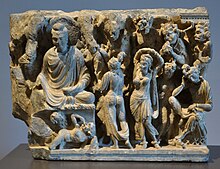
This took place at Bodh Gaya, under the famous Bodhi Tree, a probable descendent of which survives beside the Mahabodhi Temple. Buddhist tradition recounts that the enlightenment was preceded by the "assault of Mara", a demon king, who challenged the Buddha's right to acquire the powers that enlightenment brought, and asked him for a witness to attest his right to achieve it. In reply Buddha touched the ground with his right hand outstretched, asking Pṛthivi, the devi of the earth, to witness his enlightenment, which she did.[74]
The foliage of the Bodhi Tree may be shown above Buddha's head. Buddha is always shown seated in the lotus position, reaching the fingers of his right hand down to touch the ground, which is called the bhūmisparśa or "earth witness" mudra. Underneath him, the long fronds of kusa grass may be indicated. Larger depictions may show Mara and his army of demons, or his two (or three) beautiful daughters, who attempt to prevent the Buddha's enlightenment by distracting him from meditation with seductive dance movements;[75] modern South-East Asian depictions of this can be rather lurid.[76]
Pṛthivi cannot usually be seen in Indian depictions, or those of most countries, but a composition often seen in Thai depictions makes her the central figure, standing in a sort of pavilion, with the Buddha above her.[77] The account in a biography much used in South-East Asia has Pṛthivi answering Buddha's call by wringing out her hair, which produces a great flood that sweeps Mara's army away, and this may be shown in depictions, especially from Thailand and Cambodia. There are also many popular statues and figures of her wringing her hair.[78]
This event in Buddha's life is most commonly the large central scene in groups, as in the Jagdispur stele, where dozens of small demons surround the Buddha.[79]
-
AnAmaravati style, India
-
Assault of Mara, Gandhara
-
Detail of painting on silk, Mogao Caves, 10th-century.[80]
-
Modern Vietnamese depiction, with Pṛthivi wringing out her hair, to produce a flood that sweeps Mara's army away.
Meditation period

After his Enlightenment, the Buddha remained meditating in the forest for seven weeks,
Towards the end of the period (week five or six) there was very heavy rain and the giant nagaraja or cobra snake-king, Mucalinda sheltered the Buddha with the hoods of his several heads. This depiction has long been especially popular in South-East Asia, where Buddha may sit on the coiled body of the snake. Jayavarman VII, ruler of the Khmer Empire from 1181 to 1218, promoted it as "the major form of the Buddha for worship", for reasons that are now unclear.[84]
-
Pillar with Naga Mucalinda protecting the throne of the
-
12th century Khmer bronze Naga-enthroned Buddha from Banteay Chhmar, Cambodia. Cleveland Museum of Art.
Buddha's first sermon
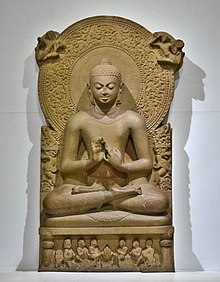
This is the third of the Eight Great Events and included in all such groupings. It is often known as the "Sermon in the Deer Park", and is recorded in the text called the Dhammacakkappavattana Sutta ("The Setting in Motion of the Wheel of the Dharma Sutta"). Among other key Buddhist doctrines it set out the Four Noble Truths and the Middle Way.[86]
It was delivered at Sarnath, some weeks after his Enlightenment, to five named disciples who had known him as an ascetic, who may be shown if they can be fitted in. Sometimes a sixth figure is shown, muscular and usually naked to the waist. This is Vajrapani, a bodhisattva who is often shown protecting the Buddha.[87] Buddha is seated, normally in the lotus position, and his hands are always shown in the Dharmachakra Pravartana Mudrā, where his two hands mime his metaphor of "setting in motion the Wheel of the Dharma". This is generally only used in images of the Buddha when representing this moment.[88]
This or the Enlightenment are usually the main large scene in stele groups. In larger groups a wheel may figure, as in a 5th-century stele at Sarnath, and sometimes one or two deer, referring to the location. These may be on the front of the base of Buddha's throne, where the disciples may also appear, much smaller than the Buddha.[89]
-
The first sermon. Gandhara.[90]
-
The Buddha's first sermon at Sarnath. Gandhara
-
The Buddha's first sermon at Sarnath. Gandhara
Conversions, miracles and offerings
For the remainder of Buddha's life he travelled around a relatively restricted area of the Indo-Gangetic plain, preaching and making converts, organizing his growing
The Buddha's ten principal disciples, who seem to be historical figures, in some cases very important figures in the early development of Buddhism, are given personalities in the literature, and various anecdotes concerning them are depicted in art, with or without the Buddha being present.[95]
The large donation by the rich merchant
Many stories involve the future rebirths of those whose actions are good. The Offering of Dust shows a story from the
Conversions
The first Buddhist converts were those present at the First Sermon. Other early converts were the three Kasyapa brothers (in some accounts there is just one Kasyapa) and their many followers. They seem to have been a group of ascetics practicing fire rituals in a form of Vedic religion, with a temple at Uruvilva on the Phalgu River, near where Buddha had been for his most austere period. Buddha asked if he could spend the night in the temple, which was allowed, but he was warned of a terrible Nagaraja (snake devi). Buddha fought the snake all night and conquered him, finally placing his remains in his alms-bowl, presenting it to Kasyapa. He converted, and became one of the ten principal disciples. In Indonesia there are early standing Buddha statues with Buddha holding his bowl with the snake in it, and the presentation of the remains is found in Gandharan reliefs.[99]
Buddha performed other miracles to convince the Kasyapas, including parting the waters of a river and mind-reading. The former is depicted on the East gate of Stupa 1 at Sanchi.[100]
Return to the family
Many of Buddha's relations eventually converted, after Buddha made a visit to his old home at Kapilavastu, perhaps at the request of his father. The moment of return is sometimes shown in art. His son
There are varying versions of the story, which are sometimes shown in art. Usually, Nanda dined with the Buddha, who passed him or left his bowl before leaving. Nanda followed him with the bowl, and the Buddha walked with him until they reached the sangha. But Nanda was some time restless as a monk, until the Buddha took him up to the
Visit of Indra to the Indrasala Cave

One rainy season retreat of the Buddha was spent in the Indrasala Cave near Rajgir, for which various locations have been proposed. While there, Indra (Sakra in Buddhism) paid the Buddha a visit, and posed him 42 questions, which he was able to answer. Indra sent a deva harpist-singer ahead to sing to the Buddha, who may be shown in depictions.[105]
These begin at Bharut and Mathura in the first century, and the illustrated panel from Mathura (50–100 AD) is one of the earliest known depictions of Buddha as a human form.[106]
The monkey's offering

One of the Eight Great Events, this took place during the Parileyyakka Retreat at Vaishali, in the tenth year after his Enlightenment. It is also called the Monkey's Offering of Honey. A monkey offers honey to Buddha, who is shown in the lotus position, with his begging bowl in his lap. In some versions the Buddha initially rejected the honey because it had bee larvae, ants or other insects in it, but after the monkey carefully removed these with a twig his gift was accepted.[108]
It is the most obscure of the eight events, not in the standard early biographical texts,[109] and relatively uncommonly depicted before it became one of the Eight Great Events around the 8th century.[110] It is also rather unclear from the texts why it is connected to Vaishali,[111] but this was an important city with other connections with the Buddha, who preached his last sermon there. He left his begging bowl in the city when he departed, and this, which became an important cetiya or relic, is the indispensable identifying element in the most reduced images, when even the monkey is not shown. The monkey may be shown, and also an elephant who also protected Buddha and gave him water. Each of these had divergent and initially unhappy after-stories. The monkey, overcome with excitement when his gift is accepted, fell or jumped down a well in some versions, but was later saved and turned into a deva,[112] or was reborn as a human who joined Buddha's sangha as a monk.[113]
-
One of the few Gandharan depictions of the monkey offering honey. His gift accepted, the monkey dances excitedly.
-
Buddha with small monkey at left; both have bowls.
Taming Nalagiri the elephant
One of the
-
Nalagiri subdued, rear of a pillar with theBhuteswar Yakshis, 2nd century.
-
Amaravarti, c. 150
-
Subjugation of Nalagiri by the Buddha, Gandhara
-
Taming Nalagiri the elephant, who appears at hedgehog size at left, withAnandaat right.
Descent from Tavatimsa Heaven

One of the
-
Descent from Tavatimsa Heaven, in the Greco-Buddhist art of Gandhara.
-
Descent from Tavatimsa Heaven (central scene), 2nd century AD, Mathura.
Miracle at Shravasti
One of the Eight Great Events, this is also called the Twin Miracle, and was performed at Shravasti (Sravasti etc). In a "miracle contest" with the Six Heretical Teachers, the Buddha performed two miracles. The first and more commonly depicted is known as the "multiplication of Buddhas", where Buddha baffles the others by multiplying his form into several Buddhas, who preach to the assembled crowd. In small pieces, however, only one Buddha figure may be shown.[119]
In the other, Buddha makes flames rise up from his upper body, while water flows from the lower parts.[120] The depiction indicates both elements by patterns on the relief, with the Buddha standing with his hand in the abhayamudra. Another miracle, with the miraculous growth of a mango tree,[121] is shown in earlier reliefs at Sanchi, but not in depictions of the Eight Great Events.
-
The Multiplication of Buddhas, Sarnath, 5th-century
-
The Multiplication of Buddhas, manuscript illustration,Nalanda, after 700
-
The miracle of fire and water, Gandhara, 3rd-century
Death of Buddha
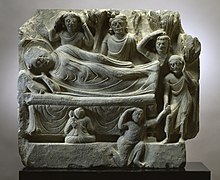
This is the last of the Eight Great Events and included in all such groupings. It is also called the Parinirvana ("entry to nirvana"). It took place at Kushinagar, Uttar Pradesh. It is normally depicted in stele groups across the centre of the top, above the main figures, with a reclining Buddha with his head to the left, usually on a raised couch or bed. As many followers as space allow are crowded round the bed, in early versions making extravagant gestures of grief; these return in later Japanese paintings.[122]
A rather small figure is often shown, typically facing out, sitting in front of the bed, usually in rather shallow relief; this is the Buddha's last convert, the ascetic Subhadra (or Sucandra). His water-sack suspended from a tripod or held in a cleft stick is ascetic equipment. He realizes that Buddha has attained final Nirvana, and does not show grief. Another monk at the front, sometimes being helped by a standing figure at the side, is Ananda, Buddha's cousin and closest companion. Sometimes a monk touches Buddha's feet.[123]

In
In Japan, where extensive narrative cycles barely exist, there are distinctive depictions of the Death (Nehan in Japanese), with large groups of human witnesses, surrounding a Buddha at a far larger scale, and (usually at the bottom of the picture space) a group of mixed species of animals.
-
Parinirvana,Kushan dynasty, late 2nd to early 3rd century, Gandhara
-
Gandhara. Shrouded Buddha, Subhadra, Ananda and tree-spirits
-
Parinirvana scene, Cave 38 at Kizil Caves, 4th century.[130]
-
Japanese painting, with animals, by Hanabusa Itchō, before 1699.[131]
-
Mourning the Death of a Gourd, parody of the Parivirvana, Shibata Zeshin, 1854 or 1859
Cremation and division of the relics
The Buddha was cremated,
-
Cremation of Buddha, Gandhara
-
Cremation of the Buddha, Māyā Cave, Kizil Caves, end 6th century
-
Division of the relics, supervised by Droma
-
Transporting Buddha's Relics, 2nd-4th century
Art history
Early aniconic representations

The earliest representations followed the general
Grouping, and narrative method
The numerous images at on the gateways at Sanchi mix up scenes from the last and previous lives of the Buddha, as well as later worship, repeat popular scenes, and are apparently arranged randomly, rather than chronologically or with any particular meaning to the sequence. This is thought to be the result of different scenes being commissioned and therefore chosen by different individuals or groups. At Bharut terse inscriptions identify the scenes, but not at Sanchi. It is likely that monks offered pilgrims guided tours of the scenes.[138]
Most of the Gandharan scenes were not excavated in a systematic manner, and many pieces had been attacked and damaged, and it is often hard to know what the overall scheme was.[139] At Borobudor the full scheme remains in position, and follows a surviving biography closely and in sequence (there are some differences, probably because the exact version of the text used has not survived).[140]
The Gandharan method of telling the story in a number of separate scenes, clearly demarcated by frames or columns, is a "definite borrowing from Roman art"; it is seen in depictions of imperial careers. It is different from the "continuous narration" seen in earlier Indian art, and that from other regions, with figures appearing more than once, and episodes blending into each other.[141] The Gandharan reliefs decorated the sides of stupas, and walls, railings and even the risers of stairs around them. Restricted space reduced the number of figures in many to a few figures, but larger panels may contain many, as do the reliefs from the eastern side of India.[142]
Locations of reliefs

At Indian stupa sites such as Barhut, Sanchi, and (to a lesser extent) Amaravati the placing of the surviving images around the stupa drum or on the railings and torana gateways is relatively clear from the best preserved sections. At Borobudor the whole monument is relatively intact. But very little sculpture survives in situ from the Gandharan structures and what did has been liable to destructive iconoclasm, earthquakes and reuse up to the present).[143]
The Gandharan sites were rather different from the early Indian ones, and offered many places for sculpture. After an early period following the massive low domes of India, after about 100 AD the main Gandharan stupas usually had a high square base, topped by a round section with a vertical wall, then a dome on top of that. Apart from large outside stupas, there were many smaller stupas either outside or built in a small shrine chamber off a larger room, mostly votive offerings. These developed a complicated arrangement of bands or zones around the stupa, all decorated differently. There might be a projecting flat "false gable" section at the front. Sculpture could decorate most stupa surfaces, but it is likely that many of the best-preserved small panels come from the drums of smaller stupas in a shrine room. A set of reliefs running round a smallish stupa might require "about eight to twenty life scenes". The choice was made by the commissioner, no doubt often with monastic advice, and many sets chose to illustrate a particular period of the Buddha's life.[144]
In the main large stupas there were wide steps rising to the top of the square base, and the vertical "riser" spaces of these were another location for sculpture. In some cases the triangular spaces at the sides created by each step also had carved reliefs, though these mostly did not feature religious scenes, but grotesques, monsters or garlands.[145]
Small reliefs, light enough to take on travels, were made as folding diptychs for monks or well-off lay persons. Two scenes on each wing was one common arrangement, often with the four main events.[146]
-
Reconstruction of stupa stairway from Hadda, Afghanistan
-
Side panel from a stairway, with "centaur-sea serpent", Gandhara
-
Small stupa from Hadda, Afghanistan
-
Bases of small votive stupas atNalanda
Rises and falls of narrative imagery

At various periods narrative images of Buddha's life decline or disappear from the surviving record over wide areas. For early periods, this is undoubtedly affected by the great majority of survivals being stone sculpture, while manuscripts, mural paintings and wood sculpture have almost all been lost.
In India, large reliefs or free-standing statues of the Buddha appear at the same time, or just a little later, as narrative reliefs, and before long these are often "Buddhist triads" with two smaller figures flanking the main Buddha, representing bodhisattvas or other Buddhas. After a few centuries images of these figures by themselves become popular,[149] and eventually more common than those of Gautama Buddha in many areas where Mahayana Buddhism dominated, reflecting changes in Buddhist thought and meditational and devotional practice.[150]
Another factor behind the relacement of narrative images was that the commissioning of images of Buddha was believed to accrue merit, and many Buddhists took the view that commissioning numerous small Buddha images was better for this than fewer large ones. Already in Gandhara, rows of small meditating Buddhas can be seen running around stupas. Later the "Thousand Buddhas" style became very popular, with large grids of small figures. These are very common in surviving Chinese murals, and on a smaller scale in manuscripts. Sometimes the Buddhas are identical, but in other works they vary in their mudras and other small details.[151]

In
The arrival of printing a new medium for illustrations of biographical writings, often for a popular market. Some of the first were for a biography by a monk called Baocheng (寶成, otherwise unknown) in Ming dynasty China, probably first published between 1422 and 1425. The biography was the first two volumes in a large work of four volumes that went on to give a history of Buddhism, especially in China, which was re-issued in various rather different blockprinted editions until the early 19th century. An edition of c. 1465–1487 has 100 illustrations in each volume, hand-coloured in the copy in the Library of Congress.[154]
See also
Notes
- ^ Pal, 39
- ^ Pal, 51; It has been suggested that the scrolling circles at the ends of the crossbars of the Sanchi gateways imitate illustrated manuscripts of a type which has not survived. Leidy, 16
- ^ Behrend (2007), 33
- ^ Pal, 51-+52
- ^ Krom, 1
- ^ Marshall, 8
- ^ Pal, 47–48
- ^ Skorupski, 162; Mandala
- Gautama Buddhafor more detail on the various estimated death dates.
- ^ Pal, 18
- ^ Brown (2003)
- ^ Brown (2003); Pal, 40–41
- ^ Brown (2003); Pal, 41–42
- ^ Brown (2003); Pal, 43–44
- ^ Brown (2003)
- ^ Pal, 18
- ^ Pons, 31–34, 36–37
- ^ Behrend (2007), 32
- ^ Bautze-Picron, 208–209
- ^ Krom, 3–10; Play, Chapter 3
- ^ Leidy, 36–37; Krom, 8–9
- ^ Soekmono, 21; Good photos, with explanations of the scenes
- ^ Varma, 072, "Maha Maya's Dream"; Pal, 40, 77–78
- ^ Pal, 77–78
- ^ Bautze-Picron, 208
- ^ In Indian accounts; elsewhere it may be a Ficus religiosa or bodhi tree. Behrend (2007), 37
- ^ Craven, 88; Nativity Scene: The Birth of the Buddha, Brooklyn Museum; Prematilleke, 164; Pal (1984), 40–41, 53, 55; Behrend (2007), 37–38
- ^ Varma, 072 – Birth Story of Gotama
- ^ Pal, 83
- ^ Shashibala, 54; Pal (1984), 70, 83–86
- ^ Sahni, 188; Buddha's first bath, V&A Museum; Karetzky, 140–141; Pal (1984), 82
- ^ Pal (1984), 19, 82; Pal (1988), 66–67
- ^ Pal, 254
- ^ Varma, 074 "Sage Asita's visit; Pal, 41
- ^ Krom, 36–38
- ^ As described in some texts: "Asita" in www.palikanon.com
- ^ The Life of Buddha, by A. Ferdinand Herold, 22–23, tr. by Paul C Blum [1922], at sacred-texts.com
- ^ Krom, 39–41; Borobudur, Lalitavistara reliefs, 035 S, The Statues worship Siddhartha photo
- ^ Pal, 66–69; Krom, 43–45
- ^ Pal, 88
- ^ Krom, 49–50; Soekmono, 22–23
- ^ Krom, 52–55; "Play", 11–113; Mahidol University
- ^ Pal, 88
- ^ His age varies between different accounts
- ^ Some accounts present this as a casual trip into the fields with friends
- ^ Japan
- Norton Simon Foundation
- ^ Soekmono, 22
- ^ Rowland, 132 (although he identifies the subject differently)
- ^ relief, British Museum
- ^ Soekmono, 23; Play, Chapter 13
- ^ Play, 152–155, 153 quoted; Mahidol University
- ^ Pal, 91
- ^ Krom, 68–74
- ^ Play, Ch 14
- ^ Like art, texts vary, describing from one to four outings.
- ^ Pal, 71, 90
- ^ Krom, 61–65
- ^ Mahidol University
- ^ Pons, 17
- ^ or yakshas, Pal, 92
- ^ Pal, 92; Pons analyses texts and depictions covering the episode in great detail, especially regarding the bowman.
- BAMPFAin California.
- ^ Pal, 94
- ^ "Relief fragment depicting Prince Siddhartha, the future Buddha, cutting his hair in renunciation", Ashmolean Museum
- ^ Bautze-Picron, 207; Sanchi panel photo
- ^ Pal, 95
- ^ Play, 189–200
- ^ Krom, 85–89
- ^ Brown (2003); Pal, 43
- ^ Krom, 91–93; Panel 84N Sujata presents food to the Bodhisattva in her Home; Women Cooking on the Right
- ^ Pal, 105; Krom, 96–98
- ^ Pal, 96–100
- ISBN 0904766535, google books
- ^ Craven, 88–90, 174; Pal (1986), 36; Krom, 102–107
- ^ For example this, from Kedah, Malaysia
- ^ Pal, 71
- ^ Pal, 102–103; Mahidol University
- ^ Pal (1984), 61; “Stone stele of the Eight Great Events of the Buddha’s Life”, The Buddha’s Biography, accessed 26 June 2022
- ^ the whole scene
- ^ six in some traditions.
- ^ Krom, 108–121
- ^ "Popular print" in the British Museum, from modern Myanmar/Burma.
- ^ Pal, 108, 161–162, 161 quoted
- ^ "The bas-relief at Pauni or Bharhut in India, which dates back to about the second century B.C., represents a vacant throne protected by a naga with many heads. It also bears an inscription of the Naga Mucalinda (Fig. 3)" SPAFA Digest: Journal Of SEAMEO Project in Archaeology and Fine Arts (SPAFA). SPAFA Co-ordinating Unit. 1987. p. 4.
- ^ Pal, 43–44; Brown (2003)
- ^ Brown (2003); Vajrapani Attends the Buddha at His First Sermon, Metropolitan Museum
- ^ Craven, 90; Pal, 109; Varma, "081 – Dhamma-Chakka-Pavattana-Katha"
- ^ Sahni, 96–99 describes several variations; Prematilleke, 164.
- ^ "Réunion des Musées Nationaux-Grand Palais". www.photo.rmn.fr.
- ^ Pal, 115; Metropolitan Museum
- ^ Pal, 115
- ^ Zin, 265–266
- ^ Leidy, 3; buddhanet, a Theravada chronology of these years, especially the monsoon retreats.
- ^ Anand, 31–33
- ^ Pal, 115; Metropolitan Museum
- ^ British Museum, Gandharan panel; Pal, 117
- ^ "On the Buddha's left, Vajrapāṇi, with long, bearded face, modelled planes of musculature, genitals, a long draped overgarment from his left shoulder passing across the legs, holds a faceted vajra with rounded ends in his left hand and raises a fly-whisk like a torch in the right." Panel #1961,0218.1. British Museum.[1]
- ^ Pal, 116; Mahidol University
- ^ Leidy, 22–23
- ^ British Museum entry
- ^ Pal, 44
- ^ Zin, 266–273
- ^ Pal, 44
- Indian Museum, Kolkata
- ^ Leidy, 23
- ^ Pal (1985), 194
- ^ Mahidol University
- ^ Pal, 48
- ^ Brown (2009), 43
- ^ Brown (2009), 47; Pal, 48 talks of "the rather contrived association".
- ^ Brown (2009), 43–52
- ^ Craven, 78; Varma, 079 – Nalgiri Elephant; Prematilleke, 167
- ^ Sahni, 189–190
- ^ Pal (1984), 112
- ^ Craven, 174; Varma, 082 – The Buddha’s Teaching of Abhidhamma; Sahni, 195–196; Prematilleke, 164
- ^ "Lhabab Duchen, Festival of the Buddha’s Descent from Heaven"
- ^ Sahni, 189, 190, 191–192, 195 describe different depictions; Prematilleke, 167;Pal (1984), 111
- ^ Craven, 174
- ^ Pal (1984), 111
- ^ Rowland, 134; Pal (1984), 19, 121–122
- ^ Behrend (2007), 41; Leidy, 40–41, she interprets the water-sack as a bag for possessions.
- ^ Pal (1984), 19
- ^ Craven, 90; Verma, 086 – Story of Parinibbana; Sahni, 185, 190–191; Prematilleke, 164–165
- ^ Pal (1986), 32–33
- ^ Pal, 122–126, 187–190
- ^ Pal, 128
- ^ Image, British Museum page
- JSTOR 20111218.
- ^ Minneapolis Institute of Art page
- ^ Leidy, 3
- ^ "The Distribution of the Relics.", Gandharan panel, British Museum; Mahidol University
- ^ Bautze-Picron, 210
- ^ Harle, 26, 32–38
- ^ Pal, 131–132; Bautze-Picron, 203–208
- ^ Bautze-Picron, 206
- ^ Leidy, 16–20; Bautze-Picron, 203–208
- ^ Behrend (2007), 3; Stewart, 6, 9
- ^ Krom, 1–3
- ^ Rowland, 132
- ^ The MAP Academy, "Gandharan Sculpture," in Smarthistory, September 12, 2022, accessed October 18, 2022, online
- ^ "Owing to deficiencies in the recording of nineteenth-century finds, the sometimes delayed or meagre publication of excavations, and above all the endemic private excavation—looting—of sculptures in the region, the great majority of extant Gandhāran sculptures have no provenance (not to mention specific find- locations)", Stewart, 6; Behrend (2009), 17–35
- ^ Behrend (2007), 32–34
- ^ Behrend (2007), 26–29
- ^ Pal, 55–56, 110
- ^ Rowland, 243, 370–371, 404
- ^ Behrend (2014), 35–36
- ^ Leidy, 32–39, she believes many depictions usually regarded as of Shakyamuni may represent other bodhisattvas or buddhas; Bautze-Picron, 197
- ^ Behrend (2014), 8–11, 27; Pal, 18; Harle, 214–215; Rowland, 255, 262, 269
- ^ Pal, 270–271
- ^ Pal, 162; Rowland, 442
- ^ Pal, 187–190
- ^ Shi shi yuan liu ying hua shi ji: si juan, Library of Congress, fully online
References
- Anand, Ashok Kumar, Buddhism in India: From the Sixth Century B.C. to the Third Century A.D., 1996, Gyan Publishing House, ISBN 9788121205061, google books
- Bautze-Picron, Claudine, "The biography of the Buddha in Indian art: how and when?" in Biographie als religiöser und kultureller Text/Biography as a religious and cultural text, Ed. Schüle, Andreas, 2002, Lit Verlag, pp. 197–239, (online at Academia.edu)
- Behrend, Kurt A., Tibet and India: Buddhist Traditions and Transformations, 2014, Metropolitan Museum of Art, ISBN 9781588395498, google books
- Behrend, Kurt A. (ed), The Art of Gandhara in the Metropolitan Museum of Art, 2007, Metropolitan Museum of Art, ISBN 9781588392244, online
- Behrend, Kurt A., The Ancient Reuse and Recontextualization of Gandharan Images: Second to Seventh Centuries CE, 2009, South Asian Studies, Ganharan Studies, vol. 2, online at www.academia.edu
- Brown, Kathryn Selig. “Life of the Buddha”, 2003, In Heilbrunn Timeline of Art History. New York: The Metropolitan Museum of Art, 2000–, online
- Brown, R. L., "Telling the Story in Art of the Monkey’s Gift of Honey to the Buddha", 2009, Bulletin of the Asia Institute, 23, 43–52, JSTOR
- ISBN 0500201463
- Harle, J.C., The Art and Architecture of the Indian Subcontinent, 2nd edn. 1994, Yale University Press Pelican History of Art, ISBN 0300062176
- Huntington, Susan L. and John C., The Art of Ancient India: Buddhist, Hindu, Jain, 2014, Motilal Banarsidass, ISBN 9788120836174, google books
- Karetzky, Patricia Eichenbaum, Early Buddhist Narrative Art: Illustrations of the Life of the Buddha from Central Asia to China, Korea, and Japan, 2000, University Press of America, ISBN 9780761816713, google books
- Krom, N. J., The Life Of Buddha On The Stupa Of Barabudur According To The Lalitavistara Text, 1926, Martinus Nijhoff, The Hague, online from the Indian Government
- Leidy, Denise Patry, The Art of Buddhism: An Introduction to Its History and Meaning, 2009, Shambhala Publications, ISBN 9781590306703
- "Mandala", "The Twelve deeds of Shakyamuni", Mandala, September–October, 2021, PDF
- Marshall, John H., The Buddhist Art of Gandhara: the Story of the Early School, Its Birth, Growth and Decline, 1960, Cambridge University Press, Internet Archive
- ISBN 087587116X, Internet archive
- "Play": A Play in Full: Lalitavistara (2013), translated by the Dharmachakra Translation Committee (complete translation from Tibetan into English)
- Pons, Jesse, The Figure with a Bow in Gandhāran Great Departure Scenes. Some New Readings, 2014, Entangled Religions, academia.edu
- Rowland, Benjamin, The Art and Architecture of India: Buddhist, Hindu, Jain, 1967 (3rd edn.), Pelican History of Art, Penguin, ISBN 0140561021
- Sahni, Daya Ram, Catalogue of the Museum of Archaeology at Sarnath, 1914, Superintendent of Government Printing, Calcutta, fully online from the Ministry of Culture, India
- Skorupski, T. , Review of Light of Asia: Buddha Sakyamuni in Asian Art, by P. Pal, 162, Bulletin of the School of Oriental and African Studies, University of London, 1988, vol. 51(1), 162–163. JSTOR
- Shashibala, Dr, Buddhist Art: In Praise of the Divine, 2003, Roli Books, ISBN 8174362177
- Soekmono, Dr, Chandi Borobudur: A Monument of Mankind, 1976, Paris: Unesco Press. ISBN 92-3-101292-4, Full PDF
- Stewart, Peter, "The Provenance of the Gandhāran “Trojan Horse” Relief in the British Museum", Arts asiatiques, 71, 2016. pp. 3–12, doi [2], online
- Varma, C. B., The Illustrated Jataka & Other Stories of the Buddha, online at the Indira Gandhi National Centre for the Arts, Indian Ministry of Culture, (refs given to page numbers and titles from the menu at left)
- Zin, Monika, "The Story of the Conversion of Nanda in Borobudur", 2006, in: Bruhn, K., Mevissen, G.J.R. (eds.), Vanamālā, Festschrift Adalbert Gail. Berlin: Weidler, pp. 265–275; online PDF
Further reading
- Ziegler, Verena, "A preliminary report on the life of Buddha Śākyamuni in the murals of the circumambulatory of the Prajñāpāramitā chapel in Zha lu (Tibet), in The Arts of Tibetan Painting: Recent Research on Manuscripts, Murals and Thangkas of Tibet, the Himalayas and Mongolia (11th −19th century), Proceedings of the Twelfth Seminar of the International Association for Tibetan Studies, Vancouver, 2010, Asian Arts
- Symbolism in Tibetan Thangkas: The Story of Siddhartha and Other Buddhas Interpreted in Modern Nepalese Painting By Ben Meulenbeld · 2001
External links
- "The Life of Buddha in Indian Art" Online feature for an exhibition at the Indian Museum, Kolkata
- May, San San, "Burmese scenes from the Life of the Buddha", British Library Asian and African studies blog, 2014


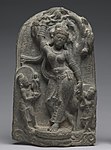
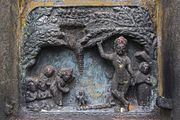
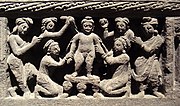

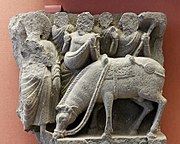
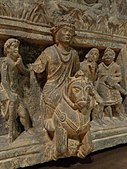
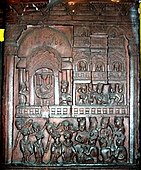

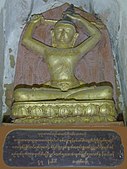

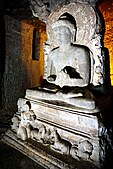
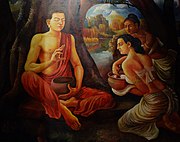
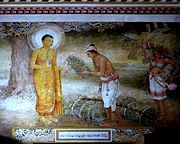
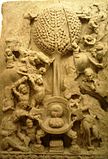

![Detail of painting on silk, Mogao Caves, 10th-century.[80]](http://upload.wikimedia.org/wikipedia/commons/thumb/8/86/FireLanceAndGrenade10thCenturyDunhuang.jpg/180px-FireLanceAndGrenade10thCenturyDunhuang.jpg)
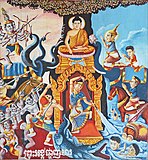
![Pillar with Naga Mucalinda protecting the throne of the Buddha. Pauni, 2nd-1st century BCE. National Museum of India.[85]](http://upload.wikimedia.org/wikipedia/commons/thumb/e/e7/Pillar_with_Naga_Muchalinda_over_the_throne_of_the_Buddha._Pauni_%28Bhandara_District%29._Railing_pillar_from_Jagannath_Tekri._2nd-1st_century_BCE.jpg/106px-Pillar_with_Naga_Muchalinda_over_the_throne_of_the_Buddha._Pauni_%28Bhandara_District%29._Railing_pillar_from_Jagannath_Tekri._2nd-1st_century_BCE.jpg)

![The first sermon. Gandhara.[90]](http://upload.wikimedia.org/wikipedia/commons/thumb/c/c0/Premi%C3%A8re_pr%C3%A9dication_%28Mus%C3%A9e_Guimet_MNAAG%2C_Paris%29_%2848544015932%29.jpg/180px-Premi%C3%A8re_pr%C3%A9dication_%28Mus%C3%A9e_Guimet_MNAAG%2C_Paris%29_%2848544015932%29.jpg)
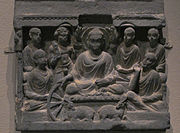



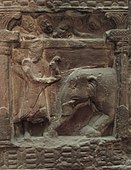










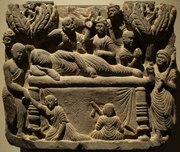
![Parinirvana scene, Cave 38 at Kizil Caves, 4th century.[130]](http://upload.wikimedia.org/wikipedia/commons/thumb/b/b5/Kizil_38%2C_Parinirvana.jpg/180px-Kizil_38%2C_Parinirvana.jpg)
![Japanese painting, with animals, by Hanabusa Itchō, before 1699.[131]](http://upload.wikimedia.org/wikipedia/commons/thumb/3/33/Hanabusa_Itch%C5%8D_-_Parinirvana_of_Sakyamuni%2C_the_Historical_Buddha_-_2013.29.2_-_Minneapolis_Institute_of_Art.jpg/125px-Hanabusa_Itch%C5%8D_-_Parinirvana_of_Sakyamuni%2C_the_Historical_Buddha_-_2013.29.2_-_Minneapolis_Institute_of_Art.jpg)
